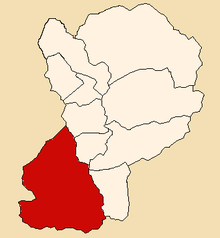Pamparomas Pamparumas | |
|---|---|
 Location of Pamparomas in the Huaylas province | |
| Country | |
| Region | Ancash |
| Province | Huaylas |
| Founded | January 2, 1857 |
| Capital | Pamparomas |
| Subdivisions | 43 hamlets |
| Government | |
| • Mayor | Adrián Palmadera Milla (2012) |
| Area | |
• Total | 496.35 km2 (191.64 sq mi) |
| Elevation | 2,862 m (9,390 ft) |
| Population (2002 est.) | |
• Total | 9,484 |
| • Density | 19/km2 (49/sq mi) |
| Time zone | UTC-5 (PET) |
| UBIGEO | 021206 |
| Website | munipamparomas.gob.pe |
The Pamparomas District is one of 10 districts of the Huaylas Province in the Ancash Region of Peru. The capital of the district is the village of Pamparomas. [1] The district was founded on January 2, 1857.